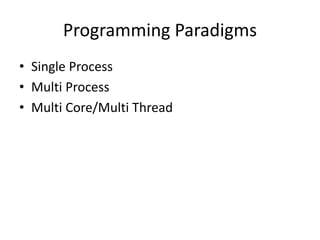The document discusses several programming paradigms including single process, multi process, and multi-core/multi-thread. It then covers topics such as processes, threads, synchronization, and liveness issues in concurrent programming including deadlock, starvation and livelock. Processes run independently while threads share data and scheduling. Synchronization prevents interference and inconsistencies between threads accessing shared data. Liveness issues can cause programs to halt indefinitely.











![Thread Subclass
public class HelloThread extends Thread {
public void run() {
System.out.println("Hello from a thread!");
}
public static void main(String args[]) {
(new HelloThread()).start();
}
}](https://image.slidesharecdn.com/u538xlhftuw3f9c0rfqo-signature-0346dba01625182d700dc07b63bab138c8074e4c32011efe290dc0ac943b5646-poli-160506145538/85/Concurrency-with-java-12-320.jpg)
![Implement Runnable Interface
public class HelloRunnable implements Runnable
{
public void run() {
System.out.println("Hello from a thread!"); }
public static void main(String args[]) {
(new HelloRunnable()).start();
}
}](https://image.slidesharecdn.com/u538xlhftuw3f9c0rfqo-signature-0346dba01625182d700dc07b63bab138c8074e4c32011efe290dc0ac943b5646-poli-160506145538/85/Concurrency-with-java-13-320.jpg)





































